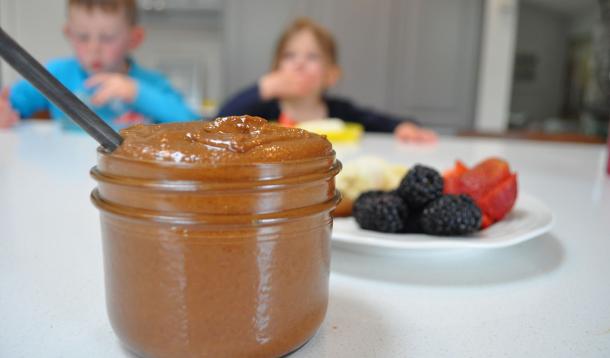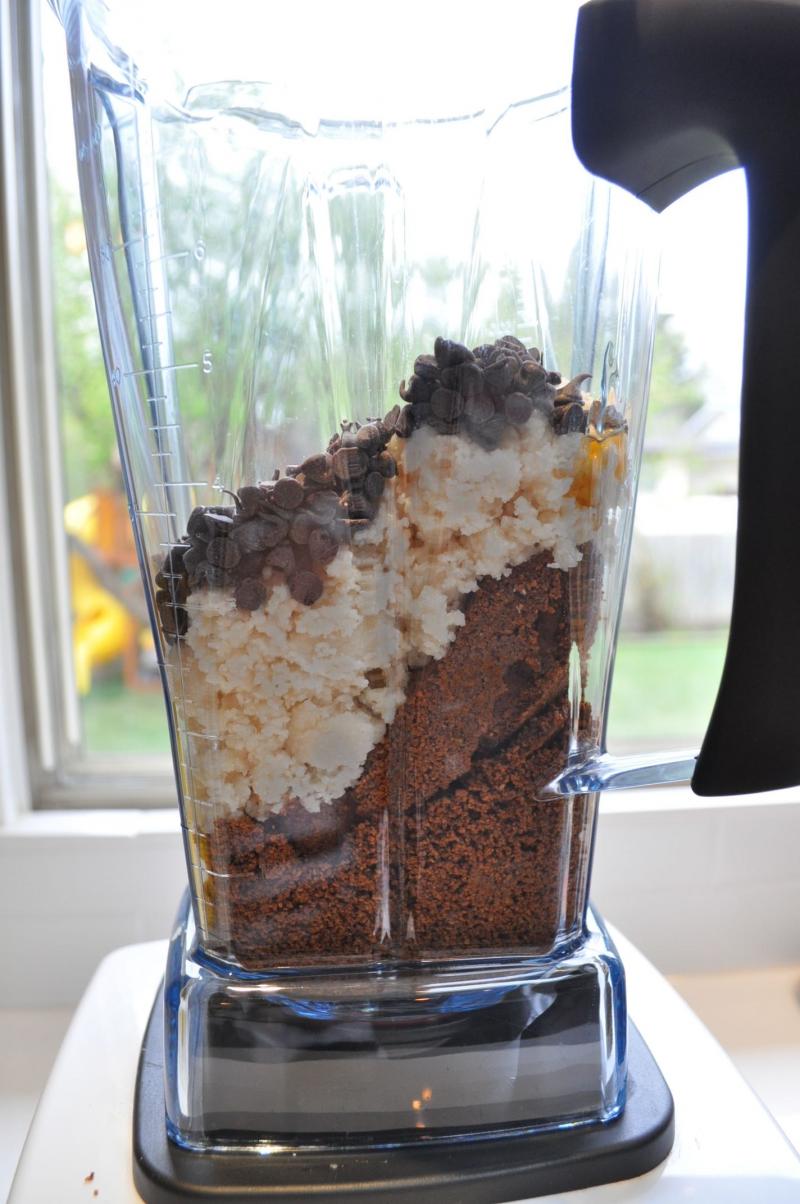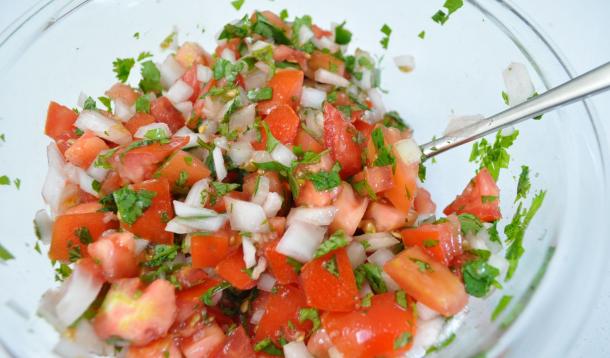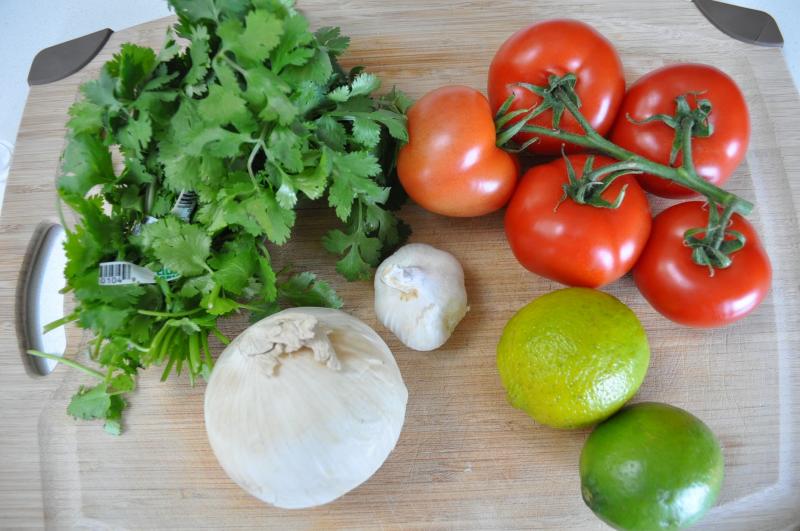
I've never been able to find the perfect store-bought nut or seed butter; one that tastes amazing and that I feel good serving my kids often. Natural nut and seed butters are fantastic nutrition-wise, but quite expensive and typically don't taste amazing to me (unless paired with a bit of honey or jam). I prefer roasted nut butters with a bit of salt and a bit of sweet (which is hard to find in store-bought form, unless you're spending upwards of ten dollars on a small jar).
I was given a really good quality blender (a Vitamix) a couple of years ago for Christmas and love using for smoothies and soups. I have heard of people making their own nut and seed butter (and their own flour!) in their blenders, but hadn't attempted it myself yet. So the other day, I decided to try my hand at making my own roasted almond butter! I love anything with coconut flavour, so I decided to add shredded coconut (and a bit of dark chocolate and honey for sweet) and it turned out to be delicious! That batch that I made is almost gone, so I might double up next time!

If you eat your nut butter often, you're likely okay to leave it unrefrigerated (in a sealed jar) for up to two weeks. Make sure to keep it in a cool and dark place to keep it from going rancid. Also, be careful not to introduce bacteria to it by always using a clean knife or spoon. After two weeks, or if you only occasionally eat it (if you think it will last you several weeks), refrigerate it. Keep in mind that it will turn solid in the fridge, so you'll have to bring it to room temperature before eating it.

*Makes about 2 cups
Ingredients
Directions
Preheat oven to 350 degrees C
 Place your almonds on a baking sheet (spread out evenly) and roast in the oven at 375 degrees for about 10-11 minutes (if you have an extra hot oven, reduce by 25 degrees). Remove from oven and allow to cool.
Place your almonds on a baking sheet (spread out evenly) and roast in the oven at 375 degrees for about 10-11 minutes (if you have an extra hot oven, reduce by 25 degrees). Remove from oven and allow to cool.
 While they are roasting, place the shredded coconut into a food processor or good quality blender and process until the coconut is "buttery"--about 8-10 minutes. You will likely need to scrape down the sides a few times.
While they are roasting, place the shredded coconut into a food processor or good quality blender and process until the coconut is "buttery"--about 8-10 minutes. You will likely need to scrape down the sides a few times.
 Transfer the coconut to a medium-sized bowl and set aside. Place roasted almonds into the food processor and process until it turns to butter (about 9-10 minutes). The butter will be warm at this point, so you can add the chocolate chips (they will melt and blend nicely), vanilla and seasalt and process for about a minute. Transfer the chocolate almond butter to the bowl with the coconut butter and combine, stirring until the two butters are one.
Transfer the coconut to a medium-sized bowl and set aside. Place roasted almonds into the food processor and process until it turns to butter (about 9-10 minutes). The butter will be warm at this point, so you can add the chocolate chips (they will melt and blend nicely), vanilla and seasalt and process for about a minute. Transfer the chocolate almond butter to the bowl with the coconut butter and combine, stirring until the two butters are one.
ALTERNATIVELY (if you have a really good quality blender):
 If you have a good quality blender and would rather use that: Follow step 1 and then place all of the ingredients into your blender and blend on medium speed (using your plunger to push ingredients down into the blade) until it becomes and nice creamy butter (about 5-6 minutes or so). Transfer to a mason jar (or other glass jar) and serve! We enjoy it on top of toast, inside smoothies, as a topping on oatmeal or as a dip for fruit!
If you have a good quality blender and would rather use that: Follow step 1 and then place all of the ingredients into your blender and blend on medium speed (using your plunger to push ingredients down into the blade) until it becomes and nice creamy butter (about 5-6 minutes or so). Transfer to a mason jar (or other glass jar) and serve! We enjoy it on top of toast, inside smoothies, as a topping on oatmeal or as a dip for fruit!
*This recipe was adapted from the Minimalist Baker's Almond Joy Butter recipe



If you'd like more easy, nutritious and kid-approved recipes, check out my Facebook page, where I post daily!
![]() Love the nut butter/chocolate combination? You'll also love these Chocolate Chia Protein Balls as well as these Flourless Peanut Butter and Banana Muffins.
Love the nut butter/chocolate combination? You'll also love these Chocolate Chia Protein Balls as well as these Flourless Peanut Butter and Banana Muffins.

My husband came home from work about a month ago declaring he needed a vacation. I agreed that I could use a get-away and we quickly started scouring the internet for last-minute vacation deals to a hot and tropical destination. With the Canadian/American exchange rate not being in our favour, we opted to go to Mexico!
We have three kids under six (one being a baby), so we knew that we were being brave by travelling to an all-inclusive Mexican resort (and potentially out of our minds), but we crossed our fingers and hoped for the best. Luckily, the hotel rooms were big enough that we felt comfortable and we were really close to the family pool, which made things a lot easier! It was a fun — albeit NOT relaxing — family get-away.
One of the most appealing parts, for me, about going to an all-inclusive resort was the fact that I could take a break for cooking and cleaning up after meals. It was REALLY nice. Although, I have to admit, I was very happy to return to my own kitchen and make home-cooked meals when we returned. One of the first things that I made though was fresh salsa. I was on a mission to re-create the amazingly delicious salsa that I ate by the boat-load everyday on our vacation. It was fresh, citrusy, garlicky and had just enough kick to it. After a couple of attempts, I think I've nailed it. And because of how easy it was to make, I honestly don't think I'll buy store-bought salsa again (very often anyway).

Ingredients

 Add all ingredients to a medium-sized bowl and mix to combine!
Add all ingredients to a medium-sized bowl and mix to combine! 


The media tends to have a huge influence on what we eat. As soon a food is deemed a "health food," it starts to fly off the shelves at warp speed. But as I mentioned in my post about nutrition labels, the media and food manufacturers are free to make over-glorified health claims where they are often unjustified. Unfortunately, as a result, health-conscious consumers often get duped into buying these products, thinking that they are making a healthy choice. I call this the "health trap."
Here are 10 "health" foods that aren't healthy at all:
Fortunately, the "gluten-free foods are healthier" craze is ending and people are finally realizing that gluten-free doesn't = healthy. People who have been diagnosed with either Celiac Disease or a gluten sensitivity need to avoid gluten, the protein found in wheat, barley, rye and some oats. With more awareness of Celiac Disease and gluten intolerance over the past few years, has come more demand for gluten-free food options, which has spurred the food industry to capitalize in a big way. What once was a tiny section of the organic aisle in the grocery store is now entire aisles of gluten-free crackers, breads, cereals, cookies and granola bars. Most gluten-free processed foods are low in fibre, vitamins and minerals but are loaded full of calories. If you do not have to avoid gluten, do yourself a favour and don't. If you must, stick to whole foods that are gluten-free and go very easy on processed gluten-free foods.
In Canada, flour manufacturers can call their flour "100% whole wheat" when it's really not. In most cases, whole wheat flour has had the wheat germ (the most nutritious part of the grain) removed during processing. The germ houses the grain's phytochemicals, protein, vitamins, minerals and fatty acids and is removed to extend the flour's shelf life. There are two things you can do to avoid this health trap: you can add 1 Tbsp of wheat germ to each cup of whole wheat or whole grain flour that you use, or you can buy flour that still contains the wheat germ such as Highwood Crossing's Stone Ground Whole Grain Flour. I love this flour because the entire whole grain is ground into a flour (nothing is removed), therefore none of the nutrition is lost.
For busy families, breakfast cereal seems to be the go-to choice for quick and easy breakfasts. It's fast, kids like it, and there is next to no prep time. But, for the most part, breakfast cereals suck in the nutrition department. Cereal is highly processed, and has had a lot of sugar, additives and preservatives (such as BHT) added in to increase the shelf life and make it taste good. Yes, there are higher fibre, lower sugar options out there, and having cereal occasionally won't do much harm, but do not be fooled–processed breakfast cereal is not a health food. Cereal often packs a punch in the calorie department, yet it doesn't fill you up for very long. This is why you may feel hungry soon after downing your bowl of Honey Nut Cheerios, only to go for a second bowl or something else carborific. If you want to make the most of your breakfast, stick to whole foods that contain more protein and naturally-occuring vitamins and minerals (such as eggs and fruit). Research shows that including protein in your breakfast will prevent unhealthy snacking later on. Here are some healthier breakfast options that are also kid-friendly.
Egg whites are one of the most overrated health foods out there. I actually cringe a little bit when I hear someone order an "egg white omelette" or "egg white breakfast sandwich". Besides the fact that egg whites alone are tasteless and boring, the yolk is the nutrition powerhouse of the egg! Most of the egg's protein, Iron, Vitamins A, D, E and B12, Folate, Selenium, Lutein, Zeaxanthin, and Choline--all important nutrients for optimal health--are found in the yolk. The yolk also contains the fat, which helps to keep us fuller longer and gives the egg its delicious flavour and texture. Now that we know that the fat and cholesterol found in eggs does not in any way increase the risk of heart disease, we no longer have to swear off the yolks. Eggs are one of natures most nutritious foods. Leave it intact, the way nature created it.
I remember when I used to run 10 km races and half marathons often, relying on some energy-dense convenience foods to get me through training sessions or to recover from a long run. I remember specifically resorting to gross-tasting protein bars when I didn't have anything else on hand. Protein bars have come a long way in the taste department, but I wouldn't touch one these days. Unfortunately, most protein bars contain a tonne of sugar (or artificial sweetener), calories, processed soy protein, and about a million additives and preservatives. Basically, most protein bars are junk food with some added vitamins and minerals. If you are really active and work out a lot, focus on whole foods to fuel up and recover from your workouts. If you find that you just can't give up your protein bar habit, choose one that contains only natural ingredients (ie. nuts, seeds, dried fruit).
Muffins have long been thought of as a healthier option at coffee shops–especially bran muffins because bran=healthy, right?! Not in this case. I still remember my health-conscious Mom choosing a bran muffin on Sundays when we stopped off at a donut shop for a treat. The truth is, her bran muffin likely contained more calories and even more fat than our donuts. Coffee shop or store-bought muffins are one of the worst "health traps" out there. Most of these muffins will contain at least a meal's worth of calories (often more) and contain as much sugar and fat as a giant piece of cake. Some even contain huge amounts of hydrogenated oils (trans fats) which most definitely puts your health at risk. If you love muffins, make your own where you can control the portion size and ingredients.
Although unsweetened fruit juice is "natural", it contains about the same amount of sugar, gram for gram, as coca cola. When fruit is juiced, the sugar is concentrated and the fibre (that fills your up) is stripped right out. Some argue that fruit juice contains vitamins and minerals, nutrients that aren't present it pop, but I would argue back that these vitamins and minerals should be consumed from whole fruits and vegetables instead of juice. The biggest beef that I have with fruit juice is that it is often recommended, and over-consumed (especially by children) in the name of nutrition. Fruit juice is not a health food. Whole fruit with the skin is. The Canadian Pediatric society recommends that kids consume no more than 1/2 cup of fruit juice per day because of its high sugar content (for good reason), but I've found (in my nutrition consulting practice and in my own home) that this can be a slippery slope. Juice is tastier than water or milk, so of course your child will want to drink it often if it's available. Most of the time, eat your fruit, don't drink it.
I love sushi just as much as the next person, but I am well aware that it is not a health food--sushi rolls at least. Most rolls contain some sort of delicious mayonnaise-type sauce as well as tempura battered shellfish. YUM. If you're a frequent sushi eater like me, focus on sashimi and sushi (raw fish alone or on top of rice) first and go easy on the tempura-battered rolls. If you go once in a while, don't worry so much about it.
Dairy foods naturally contain fat, and although this type of fat is saturated, which often gets a bad rap for it's supposed relationship with heart disease, it should not affect your overall health or weight in a negative way if you're not overdoing it. In fact, fat is satiating, meaning that it helps us to feel fuller longer because it digests slowly. It also adds a pleasurable "mouth-feel" to foods. And we NEED dietary fat for proper health. Yogurt that has had the fat removed completely will not be nearly as satisfying and filling as yogurt that contains fat. When you add an artificial sweetener in there such as aspartame or sucralose, you've got a full-on diet food that will likely spur sugar cravings and unhealthy snacking later on. Although fat-free yogurt is typically lower in calories, 9 times out of 10 you will make up those calories (plus some) by the end of the day. Instead, choose a 2% or 3% plain or lightly sweetened yogurt, either Greek (more protein and thicker texture) or regular. If you buy plain (the best), add a bit of honey or maple syrup or good old fruit to sweeten it.
Vegetarian "meat" products are often filled with a long list of interesting ingredients such as gluten, processed soy protein, canola oil, caramel coloring, whey protein and xanthan gum. If you are a vegetarian, and rely on meatless meals, choose whole protein sources such as beans, lentils, eggs, dairy, fermented soy, nuts, and seeds most of the time, and be wary of meat substitutes in a package, making sure to always check the ingredients list.
If you liked this post, you may be interested to learn the truth about "best before dates" and about how saturated fat no longer causes heart disease.